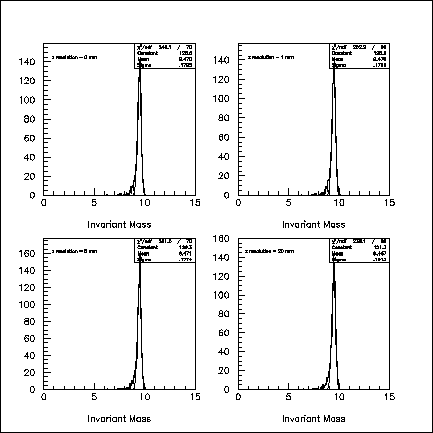 -35
-35 acceptance of the
spectrometer.
acceptance of the
spectrometer.
The creation point of the vector mesons must be known so
that the muon momentum vectors that are measured in the
tracking stations can be projected through all of the
absorber material to the vertex, and the original vector
meson mass reconstructed. The GEANT reconstruction code
uses an input resolution in z, and assumes the r/phi
interaction point is (0,0). To determine
how the vertex resolution affects the projection of the
momentum vector to the vertex, a perfect momentum resolution
was taken inside the spectrometer, and the z resolution of
the vertex was varied from perfect resolution to 2 cm
resolution. The resulting mass resolutions (for the North
muon arm) are shown in
Figure 6. The mass resolution dependence on
the z resolution was essentially the same when it was run for
the South muon arm. As can be seen, the mass resolution does
not begin to degrade until the resolution gets as large as
2 cm, and then it only degrades by approximately 7%.
We therefore require that the spectrometer be aligned
to the vertex to less than 2.0/4=0.5 cm. The same requirement
is applied to the x-y plane giving an alignment requirement
of 1-3.5 mm over the 10 -35
-35 acceptance of the
spectrometer.
acceptance of the
spectrometer.
To see if displacement of the spectrometer with respect to the vertex provided a tighter alignment constraint than smearing the vertex resolution, the muon tracking stations as well as the magnetic filed were displaced by a fixed amount relative to the interaction point, and vector mesons were reconstructed. The spectrometer could be displaced by 5.0 cm without a noticeable affect on the momentum resolution reconstructed at the vertex, which is larger than the other vertex constraint, so the alignment criterion stated in the previous paragraph will be used for the vertex alignment.

Figure 6: The mass resolution in the North muon arm of the upsilon versus
various vertex z resolutions. (Perfect spectrometer resolutions
were used for these calculations so that the contribution
from just the projection to the vertex could be seen.)